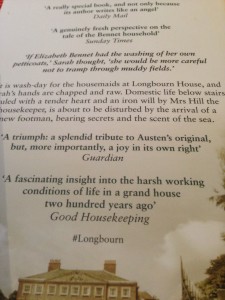 I wanted to read Jo Baker’s Longbourn once I first heard about it. ?I had been ?disappointed by ‘Death Comes to Pemberley’ and have no intention of reading the modern version of Sense and Sensibility but this novel, the giving voice to the voiceless, letting us know what might have been going through the minds of the servants below stairs, telling us about their working lives, sounded like a historical fiction novel that was worth reading. Even better, it was going to have the Pride and Prejudice story and characters in the background.
I wanted to read Jo Baker’s Longbourn once I first heard about it. ?I had been ?disappointed by ‘Death Comes to Pemberley’ and have no intention of reading the modern version of Sense and Sensibility but this novel, the giving voice to the voiceless, letting us know what might have been going through the minds of the servants below stairs, telling us about their working lives, sounded like a historical fiction novel that was worth reading. Even better, it was going to have the Pride and Prejudice story and characters in the background.
I loved it. ?I read it in two evenings last weekend. It has intrigue, class conflict, historical details, illegitimate births, unemployment, homelessness, homosexuality and much more. ?If there is one thing I detest about novels set in the past is they sometimes tend to neglect what is going on with the general populace or in politics. Baker refers to occurrences such as the Luddite uprising, and the Napoleonic war features heavily as does the militia presence in Meryton – we learn much more about the reasons for their presence here than in Austen’s book though of course, Austen would have presumed her readers understood all that. ?The book doesn’t have Austen’s irony but Baker has her own style of writing which is very pleasant to read.
We all remember Mrs Hill, the housekeeper from the book and fairly visible in the the film adaptations. There was occasion reference to another maid or two and apparently there was a single reference to a footman in the book. This is not Downton Abbey where the ladies had a devoted lady’s maid and there were an army of servants. ?While Bingley and Darcy seem to be extremely advantaged, the Bennets have a scanty staff. Sarah not only washes the clothes of all the family with the help of young Polly but also brings in water, feeds chickens and pigs, lights fires, cleans rooms, helps to cook and serve dinner not to mention the washing up. Do you remember in the book when Mr Collins enquired if any of the daughters cooked at all and Mrs Bennet was insulted, claiming they could afford to keep a cook (even though she doubled as a housekeeper!)? In Longbourn, this is contrasted with Charlotte Lucas who apparently worked in their family kitchen. The Bennet girls do not do any work beyond their embroidery.
 The book follows the Pride and Prejudice story, starting with a quote from the book but the P & P characters are very much in the background particularly at the beginning. We learn how their events impact on the staff – how Lizzy’s trek to visit Jane who is ill at the Bingley’s results in Sarah having to scrub her petticoats for hours, how the arrival of the Gardiner children results in so much more work as it includes the washing of nappies, how one of the staff has to stay up when they go to a ball even though they have to get up early. While Austen would never refer to visiting a privy, Baker mentions the emptying of the chamber pots quite often. ?Baker explains the detachment at the beginning of the novel by saying how the girls scarcely make eye contact with the servants, conscious that these girls scrub their clothes and see their secrets. Although as Lizzy and her siblings seem consumed with their own problems later in the novel, they do seem to converse with the servants more. ?However, servants are expected to undergo hardship – Sarah is told to hope for good weather when they go travelling to London in the carriage as she will be sitting on the perch at the back, totally unprotected from the elements.
The book follows the Pride and Prejudice story, starting with a quote from the book but the P & P characters are very much in the background particularly at the beginning. We learn how their events impact on the staff – how Lizzy’s trek to visit Jane who is ill at the Bingley’s results in Sarah having to scrub her petticoats for hours, how the arrival of the Gardiner children results in so much more work as it includes the washing of nappies, how one of the staff has to stay up when they go to a ball even though they have to get up early. While Austen would never refer to visiting a privy, Baker mentions the emptying of the chamber pots quite often. ?Baker explains the detachment at the beginning of the novel by saying how the girls scarcely make eye contact with the servants, conscious that these girls scrub their clothes and see their secrets. Although as Lizzy and her siblings seem consumed with their own problems later in the novel, they do seem to converse with the servants more. ?However, servants are expected to undergo hardship – Sarah is told to hope for good weather when they go travelling to London in the carriage as she will be sitting on the perch at the back, totally unprotected from the elements.
Things change when the new footman, James Smith arrives and an element of intrigue is introduced. What is his secret? Why does Mrs Hill not want him there? Why has he sought employment there when there is a war on? Is Sarah attracted to him or to Bingley’s footman? The love triangle is a little bit clich?d but it doesn’t really detract.
Baker confirms the answer to one question that was always in my mind when reading P & P. Did Mary want to marry Mr.Collins? Why didn’t he want to marry her, they seemed a much better match than he and Lizzy.
I do think this is a book that will have much divided opinion. Some will hate it, some will love it, very few will sit in the middle with their opinion. Yes, some of the P & P characters seem shallow and selfish but they did in Austen too. Mr Bennet’s selfishness was a bit of a surprise and I had hoped Lizzy would almost be another heroine. Mr Darcy seems threatening and proud – in the eyes of the servants and we are even more convinced of Wickham’s wicked ways. The ending is a tad convenient. However, I felt like I was reading another version of an old friend and as long as readers aren’t too precious about Austen, I think most people will too.
Apparently there was a bidding war on the book and the film rights have been sold so we can look forward to seeing it on the screens sometimes.
 Something else that was interesting was the use of the hashtag #longbourn being placed very subtly on the back of the book. ?I loved the idea and did a ‘why didn’t I think of that?’ especially as the latest print run has just arrived and I’d been using the hashtag #marryafarmer at times. After all, hashtags are used for TV programmes and radio shows now. Maybe it is because it is coming out as a film. ?I love the idea of being able to discuss books on twitter by finding other readers via the hashtag and seeing what others thought – in nice succinct 140 character tweets. As far as the author and publisher are concerned, they can engage with the tweeters if they wish and see the response. So far though, it isn’t being used that much.
Something else that was interesting was the use of the hashtag #longbourn being placed very subtly on the back of the book. ?I loved the idea and did a ‘why didn’t I think of that?’ especially as the latest print run has just arrived and I’d been using the hashtag #marryafarmer at times. After all, hashtags are used for TV programmes and radio shows now. Maybe it is because it is coming out as a film. ?I love the idea of being able to discuss books on twitter by finding other readers via the hashtag and seeing what others thought – in nice succinct 140 character tweets. As far as the author and publisher are concerned, they can engage with the tweeters if they wish and see the response. So far though, it isn’t being used that much.
Will I put #marryafarmer on my next print run (if there is one)? ?Still mulling it over but to be honest, I think it is a great idea.
Have you read it? I’d love to hear what you think.









M T McGuire
It sounds intriguing to me. 😉
Cheers
MTM
Lorna
Look forward to hearing what you think if you give it a go 🙂
Starting your book here next week 🙂